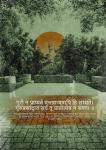The Vedas, means“knowledge,” are the oldest texts
of Hinduism. The expression "Vedic" is derived from
the Sanskrit word veda, which means knowledge or
revelation. According to the Vedic history, they were
written down thousands of years ago. The date,
however, is not very important because, without a
doubt, the knowledge contained in these scriptures
was existing a long time before it was written down.
The four Vedas: The scriptures of this category are
generally labeled as the original Vedic scriptures.
These four Vedas are known as Rig, Yajur, Sama and
Atharva. Rig means ritual, and it contains mainly
hymns and prayers (Mantras) in the worship of the
universal forces called the demigods. Yajur means
ceremony, and it mainly describes how to perform
the rituals. Sama means singing; the scriptures of
these categories contain many other mantras as
well as strict rules how to chant these mantras
according to mystic vibrations. Atharva means a
priest who knows the secret lore; these scriptures
describe many different kinds of worship and
invocations. In a broader sense, many other
scriptures of material knowledge are also counted
in the Atharva, like the Ayurveda (pharmacological
sciences and the means to maintain health).
India has always boasted of a rich tradition in the area of learning and education since ancient times. It is well known that
people from other nations such as Europe, the Middle East, and Portugal came to India to get a quality education. One of
the famous educational systems practised in India in the ancient times was The Gurukul System. In ancient India teaching
was considered to be holyduty which a Brahman was bound to discharge irrespective of consideration of the fee teacher
were expected to devote their lives to the cause of teaching in the missionary spirit of self-sacrifice, and the society laid
down the principal that both the public and state should help the learned teachers & educational institutions very
liberally. Society realized that “Vidyadana” or the gift in the cause of education was tobe the best of gifts, possessing
a higher religious merit than even the gift of land. On the occasion of religious feats, students and teachers were
invited and donations were given liberally.
2021
0000
“Ayodhya, Mathura, Maya (Mayapuri or Haridwar), Kashi (Varanasi), Kanchi (Kanchipuram), Avantika (Ujjain) and Dwaravati (Dwaraka); These seven cities
are giver of Moksha (Liberation) and are called Mokshapuri.
An ancient town, Ayodhya is regarded as one of the seven sacred cities of the Hindus, revered because of its association in the great Indian epic
poem Ramayana with the birth of Rama and with the rule of his father, Dasharatha. According to this source, the town was prosperous and well
fortified and had a large population.
HISTORICAL RELEVANCE
Ancient Hindu Sanskrit-language epics, such as the Ramayana and the Mahabharata mention a legendary city called Ayodhya, which was the capital
of the legendary Ikshvaku kings of Kosala, including ama. Neither these texts, nor the earlier Sanskrit texts such as the Vedas, mention a city called
Saketa. Non-religious, non-legendary ancient Sanskrit texts, such as Panini's Ashtadhyayi and Patanjali's commentary on it, do mention Saketa.
The later Buddhist text Mahavastu describes Saketa as the seat of the Ikshvaku king Sujata, whose descendants established the Shakya capital Kapil-
-avastu. Religion had played a role for controlling power in Indian monarchy in the ancient past, and in contemporary India too it played a role in
the formation of religious landscape and religious heritage, through commonly using processions, pilgrimage, religious assemblies, religious fairs
(melā), and sacred places. Ayodhya - Faizabad represents an aesthetic and unique type of cultural landscape and heritage scape that include
natural, cultural, tangible and intangible heritages, and variety of cultural landscapes. The city’s cultural landscapes, are illustrated with riverfront
sacred scapes and faith scapes, sacred sites associated with Hindus, Jains, Sikhs, Buddhist and ever Sufis (and other Muslims), and several
other small congregations. Ayodhya, being one of the most sacred places is known as the legendary capital of Rama; and nowadays one of the
most important places of pilgrimage in India with special reference to its sacred cultural landscapes. Ayodhya, situated on the right bank of Ghagh-
-ara River (Sarayu).
LOCATION
The proposed site for Gurukul:A vedic paathshala is located on shree Ramjanmbhoomi kshetra, Ayodhya, Uttar Pradesh. The proposed site for Shree
Ramjanmbhoomi kshetra, Ayodhya, Uttar Pradesh, has main access from Faisabad-Ayodhya road.
SHAPE AND SIZE:-
The site is irregular in shape with an area of 67.924 acers i.e. 274880.551 SQ.MTS.
Individual Thesis project

















